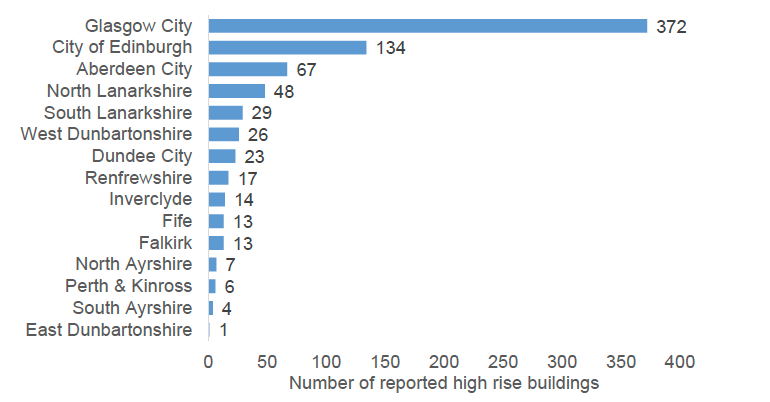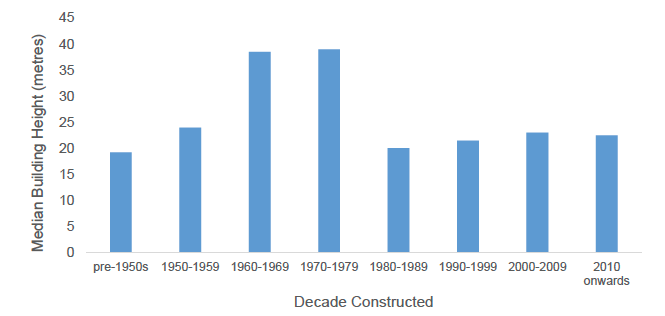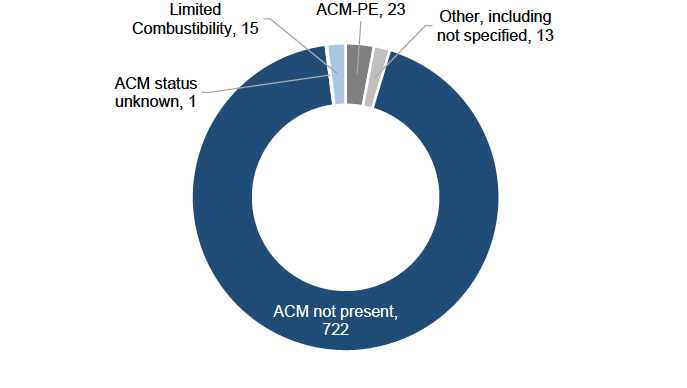High Rise Inventory: summary report
The High Rise Inventory (HRI) provides information on the construction and fire safety of high rise domestic buildings.
Summary Report
Background
1. The Ministerial Working Group on Building and Fire Safety was established in 2017 to oversee a review of building and fire safety regulatory frameworks, and any other relevant matters, to help ensure that people are safe in Scotland's buildings, and make any recommendations for improvement as required. As part of the Group's work plan, the development of a central source of information on key aspects of the construction and fire safety features of high rise domestic blocks was agreed.[1]
2. The High Rise Inventory (HRI) provides information on the construction and fire safety of high rise domestic buildings. A high rise domestic building is defined in building regulations as a domestic building with any storey at a height of more than 18 metres above the ground, and the HRI therefore includes data for both larger tenemental style buildings as well as those that might be more commonly understood as traditional high rise flatted accommodation. The HRI data collection has been delivered through the Scottish Government's ScotXed Unit, and continues initial data collection commissioned from Capita in 2018. It has been completed by Local Authority Building Standards departments for all relevant buildings, with data provided or verified to the best of the respondents' knowledge at the time of completing the inventory, and should be treated as a snapshot in time.
3. This summary report is based on information held in the HRI in February 2020. The HRI exercise is to be an annual undertaking, following an iterative process of improvement. While there is a small amount of missing data (see paragraph 6), it is intended that this will be addressed in future exercises. Some information however may simply not be available due to e.g. redaction of building warrant information from paper files of a significant age.
4. The HRI data collection is a significant undertaking. Local Authority Building Standards efforts in compiling the collection, and the efforts of Registered Social Landlords (RSLs) in the original 2018 exercise and any relevant subsequent validation, are acknowledged. It can be expected that following this collection, future HRI exercises will be less intensive, requiring for the majority of buildings a more straightforward validation of the data sourced for this initial exercise.
Completion rates
5. The HRI contained a maximum of 27 questions (Annex A). Most of these questions were adapted from the 2018 exercise, allowing for pre-population and respondents' subsequent verification and update as required. Guidance was also issued with the questionnaire to further aid entering responses.
6. Completion rates for each question are also included at Annex A. Questions which dropped below a 90% completion rate included:[2]
- Question 2.2. – What is the estimated lifespan of the building (79% complete)
- Question 3.1.1 – If this is a Large Panel System type building, does it have a mains gas supply? (87% complete)
- Question 3.5.1 – If yes, please identify type (of insulation materials exposed in the external wall cavity). (88% complete)
Data Returned: Key Findings[3]
7. A total of 774 high rise building records were submitted to the HRI, with locations across 15 Local Authorities. 48% of these, representing 372 buildings, are in Glasgow. A map showing the number of reported domestic high rise buildings is provided in Annex B. Where building information was provided, Registered Social Landlords are the most common building owners (36%, 275 buildings).
8. The most common completion date for domestic high rise buildings in Scotland is the 1960s (46%, 354 buildings), with the oldest two buildings reported as being completed pre-1950s.
9. Reported building heights range from 18m to 71.5m, with a median height of 31.5m. The tallest reported buildings are located in Glasgow.
10. There are a reported 46,530 flats in high rise buildings in Scotland.
11. The most common construction type reported for high rise buildings in Scotland is concrete frame (60%, 457 buildings), with the majority of buildings a single construction type (57%, 438 buildings).
12. Aluminium Composite Material (ACM) panels are identified in a small number
of buildings (7%, 51 buildings) where information was provided. Of these,
23 buildings reported polyethylene type ACM panels (ACM-PE), a combustible material. Thirteen buildings reported an alternative type of ACM, of which six buildings reported limited area spandrel panels with unknown fire classification and three buildings with panels in lift lobbies and stairwells.
13. Sprinklers or other forms of automatic fire suppression equipment are reported in 300 buildings (39%, where information provided). Fire doors are fitted to all flat doors for 87% (670) of buildings. Fire doors are fitted to all escape stairs for 92% (711) of buildings.
Data Returns: General Information
14. A total of 774 high rise building records were submitted to the HRI, with locations across 15 Local Authorities. 48% of these, representing 372 buildings, are in Glasgow (Figure 1).

15. Registered Social Landlords (RSLs) are the most common building owners, where information was provided (36%, 275 buildings), followed by Local Authorities (33%, 255 buildings) and private owners (32%, 244 buildings).[4]
16. The majority of all RSL and privately owned high rises are in Glasgow (84% and 58% respectively). 34% of privately owned high rises are in Edinburgh. Over half of the 255 LA owned high rises are in Aberdeen City (59 buildings), North Lanarkshire (48 buildings) and City of Edinburgh (42 buildings) (see Table 1).
Table 1: Reported High Rises in each Local Authority Area by Building Owner
| Building Location | Local Authority | RSL | Private | Total |
|---|---|---|---|---|
| Aberdeen City | 59 | 0 | 8 | 67 |
| Dundee City | 11 | 6 | 6 | 23 |
| East Dunbartonshire | 0 | 0 | 1 | 1 |
| City of Edinburgh | 42 | 9 | 83 | 134 |
| Falkirk | 13 | 0 | 0 | 13 |
| Fife | 12 | 0 | 1 | 13 |
| Glasgow City | 0 | 231 | 141 | 372 |
| Inverclyde | 0 | 13 | 1 | 14 |
| North Ayrshire | 7 | 0 | 0 | 7 |
| North Lanarkshire | 48 | 0 | 0 | 48 |
| Perth & Kinross | 6 | 0 | 0 | 6 |
| Renfrewshire | 14 | 3 | 0 | 17 |
| South Ayrshire | 3 | 0 | 1 | 4 |
| South Lanarkshire | 21 | 6 | 2 | 29 |
| West Dunbartonshire | 19 | 7 | 0 | 26 |
| Total | 255 | 275 | 244 | 774 |
Data Returns: Building Information
17. Data returns submitted to the HRI indicate that the most common completion date for domestic high rise buildings in Scotland is the 1960s (46%, 354 buildings), followed by the 2000s and 1970s. The oldest two buildings were completed before the 1950s. The estimated remaining lifespan of high rise buildings ranges from 5 years to 100 years. The most commonly reported remaining lifespan was 30 years, although a low question completion rate (79%) means that the true lifespan distribution may be different to that collected. Information on the projected lifespan of a building is not included in Building Warrants or Building Standards certification, and feedback received through the HRI data collection indicated that this was subjective and sometimes challenging data to provide, involving economic as well as structural considerations. Amendment of this question shall be included in considerations for future HRI data collections.
18. Reported building heights range from 18m to 71.5m, with a median height of 31.5m. The tallest reported high rises are in Glasgow. On average, Renfrewshire has the tallest high rise building estate, with a median of 45m across its 17 high rises. The tallest buildings were constructed in the 1960s and 1970s, with a median height of 38.5m and 39m respectively (see Figure 2). The reported number of storeys ranges from 5 to 26, with a median of 12.
19. There are a reported 46,530 flats in high rise buildings in Scotland.

Data Returns: Construction
20. Data returns submitted to the HRI indicate that concrete frame (reported in 457 buildings, 60% of all records) is the most common construction type.[5] A range of other construction types were identified as follows, with more than one construction type per building possible: Large Panel System (LPS) – concrete (26%, 197 buildings); steel frame (21%, 163 buildings); LPS – cassette (4%, 28 buildings); and LPS – structural insulated panels (1%, 11 buildings). An alternative construction type, highlighted through free text response, was reported in 294 buildings, 38% of returns. However, these may overlap with the other categories listed. Where a multiple construction type was identified, 269 buildings had two construction types (35% of all buildings); and 58 buildings had three construction types (7% of all buildings).
21. Of those buildings reporting an LPS-type construction, 59 have a mains gas supply. 22 LPS-type buildings are missing mains gas information.[6]
22. Rendered External Wall Insulation (EWI) is reported on 426 buildings (55% of all buildings).[7]
23. Returns submitted to the HRI indicate that Aluminium Composite Material (ACM) panels are present in a small number of buildings (7% where ACM questions answered, 51 buildings). Of these, 23 buildings reported polyethylene type ACM panels (ACM-PE), a combustible material. A further 15 buildings reported limited combustibility ACM and 13 had other or non-specified ACM panel types (Figure 3). Local Authority Building Standards departments have subsequently indicated that the process of replacement of ACM-PE on buildings where it has been reported is planned or underway.
24. An alternative type of ACM was reported in 13 buildings, of which six buildings reported limited area spandrel panels with unknown fire classification and three buildings with panels in lift lobby and stairwell. (Figure 3).

25. Other types of external wall panels are reported in 489 buildings (63% of all buildings). Where the type of external wall panels is identified, types include: masonry infill (33%, 160 buildings); rainscreen insulation board (13%, 63 buildings); zinc (10%, 49 buildings); high pressure laminate (8%, 40 buildings); terracotta tiles (8%, 37 buildings); stone (6%, 30 buildings); solid metal panels (6%, 30 buildings); other metal composite (4%, 18 buildings); granite (3%,14 buildings); slate (1%, seven buildings); and concrete panels (<1%, two buildings). In 68% of buildings where external wall panels were reported, other types of external wall panel are identified using free text responses.
26. In total, 231 buildings are reported with insulation materials exposed in the external wall cavity (30% of all buildings). Where the type of exposed insulation is identified, stone wool is the most commonly reported (78 buildings), representing 34% of buildings where exposed insulation is reported, and 10% of all buildings overall. However, 57% of buildings where exposed insulation is reported returned free text responses, which may overlap with other categories. Phenolic foam is reported for 29 buildings, polyisocyanurate in five buildings and four buildings are reported with exposed expanded polystyrene insulation..
Data Returns: Fire Safety
27. Data returns submitted to the HRI indicate 83% of buildings have one escape stair and 17% have two escape stairs or more.
28. Fire doors are fitted to all flat entrances in 670 building (87% of all buildings) and a partial number of flat entrances in 48 buildings (6% of all buildings). Of the 36 buildings (5% of all buildings) where fire doors are not fitted to flat entrances further details are provided for 34 buildings. There were some instances where fire doors fitted to flat entrances were stated but the fire stopping integrity of privately owned flat doors within LA-owned high rises is unknown.
29. Fire doors are fitted to all escape stairs, or a partial number of escape stairs, in 713 buildings (92% of all buildings). Of the 59 buildings (8% of all buildings) where fire doors are not fitted to escape stairs, further details are provided for 56 buildings. A small number detail planned installations, but the majority clarify fire doors are to be fitted to flat entrances, rather than escape stairs.
30. Sprinklers or other forms of automatic fire suppression systems (AFSS)[8] are reported as present in 300 buildings (39% of all buildings). Information is missing for eight buildings (1%). The most common type of system is sprinkler (261 buildings, 87% of those with AFSS), then mist (35 buildings, or 12% of buildings with AFSS), with other forms of system present in three buildings (2% of those with AFSS). For those buildings where sprinklers or other forms of AFSS have been identified, they are most commonly found in bin stores (240 buildings), flats (23 buildings), and common corridors or stairwells (23 buildings). For 38 buildings, alternative AFSS locations were provided by free text response – of these, 31 buildings have AFSS located in car parks.
Conclusions and next steps
31. This summary report is based on information held in the HRI collection in February 2020 and should be treated as a snapshot in time. The HRI exercise has been a comprehensive undertaking and the efforts of those involved in its compilation are acknowledged.
32. Realising the objective of the Ministerial Working Group on Building and Fire Safety for a central source of information on key aspects of the construction and fire safety features of high rise domestic blocks, it is also a significant first step towards the recommendations in the Hackitt Report for a 'golden thread' of good quality information. It is also central to related work of the Ministerial Working Group e.g. in establishing the extent of the use of external High Pressure Laminate (HPL) cladding, and in the development of fire safety guidance for high rise buildings.
33. Beyond the fundamental information collated in the HRI (e.g. on building location or completion date), unknown data remains and the collection has also identified a number of potential issues which have been or are being addressed with relevant bodies. These include:
- ACM – in the period following the Grenfell Tower fire, data was collected on buildings with ACM-PE installed. This data collection was coordinated through Local Authority Building Standards departments. The Scottish Government has since continued to engage with relevant Local Authorities on plans for replacement and management of ACM-PE cladding on buildings.
- Fire doors – requirements for fire doors in high rise housing have changed over time. Prior to 1 May 2005 requirements were for doors providing 30 minutes fire separation, with the requirement thereafter for 60 minutes fire separation. Older fire doors should still provide resistance and even non-fire rated doors should provide some resistance to fire. Where HRI returns indicate fire doors are not fitted to flat entrances or escape stairs, follow-up is being undertaken to enquire why this is the case and what actions are being taken. Scottish Fire and Rescue Service (SFRS) has also been made aware.
34. With the conclusion of the 2020 HRI exercise, data shall be collected from the SFRS on reported buildings regarding any outstanding defects highlighted through their operational assurance visits. SFRS undertake operational assurance visits to high rise domestic buildings in Scotland, with a Standard Operating Procedure in place for these to take place on a quarterly basis. The purpose of these inspections is to obtain information for operational purposes and to ensure compliance with Regulatory requirements relating to the common areas of private dwellings.
35. As the HRI is to be an annual undertaking, it may be expected that any outstanding defects identified through the 2020 exercise shall be addressed as required in future iterations. Given the HRI's scale and scope, and the challenges of delivering an inventory for the first time, it can be further expected that data collection processes will be refined and improved for future exercises. There will also be an iterative process of improvement while questions are considered and improved where necessary for future data collections.
Contact
Email: karen.coyne@gov.scot
There is a problem
Thanks for your feedback